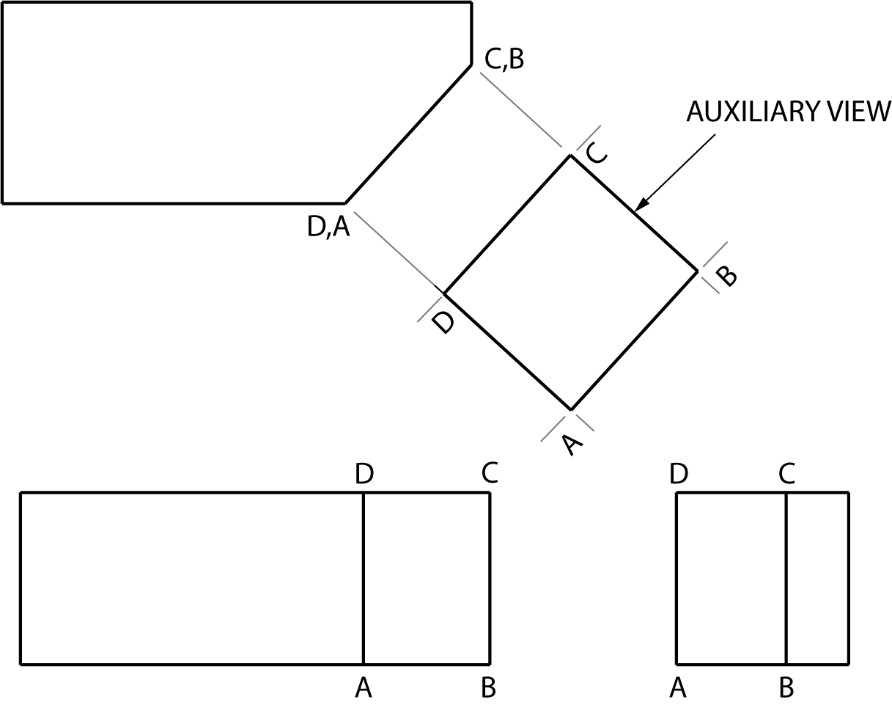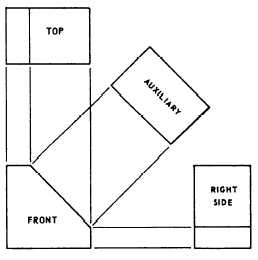Auxiliary views projection 1304 engr lines adjacent
Table of Contents
Table of Contents
If you’re in the realm of engineering or design, you’ve likely encountered situations where a standard drawing doesn’t give you enough of the information you need to get the job done. This is where auxiliary views come in. If you want to take your designs to the next level, it’s worth learning how to draw an auxiliary view.
Figuring out how to draw auxiliary view can be a pain point for many people. It can be tricky to wrap your head around the concept at first, and it can take a bit of time and practice to really get the hang of it. Additionally, if you’re not familiar with the relevant terminology and techniques, you might find yourself making mistakes or getting stuck along the way.
At its core, an auxiliary view exists to help clarify the details of a drawing that might not be immediately clear from a standard view. By creating an auxiliary view, you can show an object from a different angle, giving you a more complete picture of its shape and size. Ultimately, this can help make your designs more accurate and more effective.
So, how do you actually draw an auxiliary view?
The first step is to determine which view will best help you communicate the information you need to convey. This will depend on the object you’re drawing and the details you want to highlight. Once you’ve identified the best angle for your auxiliary view, you’ll need to set up the drawing surface, aligning it with the object’s edges and contours. Then, you can begin drawing in the lines and shapes that will create your auxiliary view.
My experience with drawing auxiliary views
When I first learned about auxiliary views, I felt a bit intimidated by the concept. It seemed like a complicated technique that only seasoned professionals could handle. However, once I actually started practicing and experimenting with different approaches, I found that it wasn’t as hard as I thought it would be. In fact, I found that drawing auxiliary views helped me to view objects in a new way, making it easier to visualize their shapes and dimensions.
Tips for success when drawing auxiliary views
If you want to master the art of creating auxiliary views, there are a few key tips that can help. First, make sure you have a good understanding of the object you’re drawing and the relationships between its various parts. This will help you choose the most effective angle for your auxiliary view. Additionally, take your time and be precise with your measurements and lines. Small details can make a big difference in the accuracy and clarity of your auxiliary view. Finally, don’t be afraid to experiment and iterate as you work. Sometimes, the best approach will only become clear after you’ve tried a few different things.
Using auxiliary views in your designs
Once you’ve mastered the art of creating auxiliary views, you can start using them to enhance your designs in a variety of ways. For example, you might use an auxiliary view to show a cross-section of an object, highlighting its internal features. Or, you might use an auxiliary view to give a more complete picture of an object’s size and shape, which can be especially useful in situations where the object will need to fit into a specific space. Overall, auxiliary views are a valuable tool for designers and engineers alike, and mastering their creation can help take your designs to the next level.
Common mistakes to avoid when drawing auxiliary views
While drawing an auxiliary view can be a useful technique, there are a few common mistakes that people often make. One of the biggest is choosing the wrong angle for the auxiliary view, which can lead to confusion and inaccuracies. Another mistake is failing to align the drawing surface properly, which can throw off your measurements and make the auxiliary view less effective. To avoid these and other mistakes, it’s important to take your time and be meticulous as you work through the process.
Question and Answer
Q: Why are auxiliary views important?
A: Auxiliary views are important because they allow you to communicate detailed information about an object that might not be immediately clear from a standard view. By creating an auxiliary view, you can show an object from a different angle, giving you a more complete picture of its shape and size.
Q: Are auxiliary views difficult to draw?
A: Drawing an auxiliary view can be tricky at first, but it’s a skill that can be learned with practice. By familiarizing yourself with the relevant terminology and techniques, and taking your time as you work through the process, you can create accurate and effective auxiliary views.
Q: Are there different types of auxiliary views?
A: Yes, there are several different types of auxiliary views you may encounter in your work, including true auxiliary views, inclined auxiliary views, and partial auxiliary views. Each type has its own advantages and challenges, and choosing the best type for your needs will depend on the specific object and details you’re trying to convey.
Q: Can auxiliary views be used in any type of design or engineering work?
A: Yes, auxiliary views can be useful in a variety of different fields and applications, from mechanical engineering to architecture. If you need to convey detailed information about an object’s shape or size, an auxiliary view can be a useful tool to add to your arsenal.
Conclusion
Learning how to draw auxiliary views can be a valuable skill for anyone working in the fields of design or engineering. By using auxiliary views, you can clarify the details of a drawing that might not be immediately clear from a standard view, giving you a more complete picture of an object’s shape and size. By taking your time and being meticulous as you work through the process, you can create accurate and effective auxiliary views that take your designs to the next level.
Gallery
ENGR 1304: Ch5 Auxiliary Views
Photo Credit by: bing.com / auxiliary views projection 1304 engr lines adjacent
Auxiliary Views – Basic Blueprint Reading

Photo Credit by: bing.com / auxiliary blueprint libretexts
Perspective Drawings

Photo Credit by: bing.com / auxiliary drawings drawing views front perspective figure section three find orthographic tpub
Auxiliary View - Its Types, Methods. [A Comprehensive Guide].
![Auxiliary View - Its Types, Methods. [A Comprehensive Guide]. Auxiliary View - Its Types, Methods. [A Comprehensive Guide].](https://civilseek.com/wp-content/uploads/2018/10/auxiliary-view.jpg)
Photo Credit by: bing.com / auxiliary inclined civilseek
What Is Auxiliary Plane | Types Of Auxiliary Plane | Types Of Auxiliary

Photo Credit by: bing.com /






